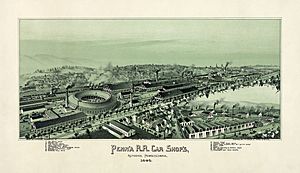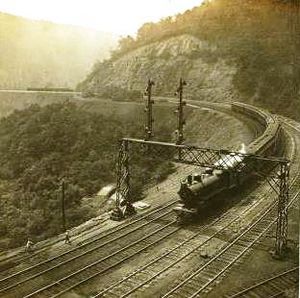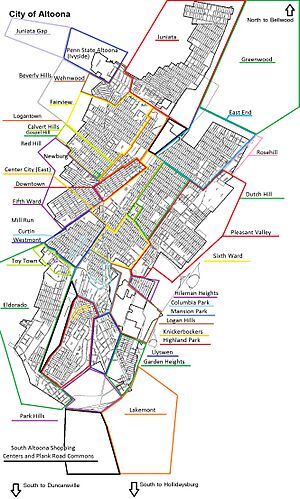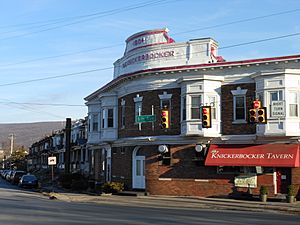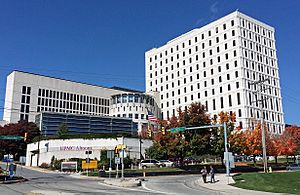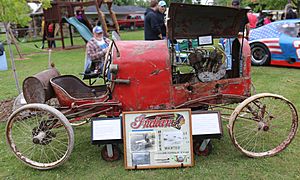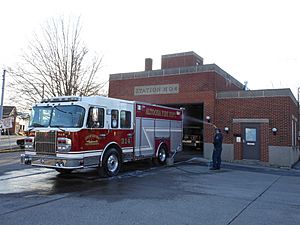Altoona, Pennsylvania facts for kids
Quick facts for kids
Altoona
|
|||||
|---|---|---|---|---|---|

Altoona seen from Brush Mountain in September 2011
|
|||||
|
|||||
| Nicknames:
The Mountain City, Railroad City
|
|||||

Location of Altoona in Blair County, Pennsylvania.
|
|||||
| Country | United States | ||||
| State | Pennsylvania | ||||
| County | Blair County | ||||
| Founded | 1849 | ||||
| Incorporated (borough) | February 6, 1854 | ||||
| Incorporated (city) | 1868 | ||||
| Area | |||||
| • City | 9.79 sq mi (25.36 km2) | ||||
| • Land | 9.79 sq mi (25.36 km2) | ||||
| • Water | 0.00 sq mi (0.00 km2) | ||||
| Elevation | 1,161 ft (354 m) | ||||
| Population
(2020)
|
|||||
| • City | 43,963 | ||||
| • Density | 4,490.14/sq mi (1,733.67/km2) | ||||
| • Urban | 79,930 | ||||
| • Metro | 121,829 | ||||
| • Demonym | Altoonian | ||||
| Time zone | UTC−5 (EST) | ||||
| • Summer (DST) | UTC−4 (EDT) | ||||
| ZIP Codes |
16601–16603
|
||||
| Area code(s) | 814 | ||||
| FIPS code | 42-02184 | ||||
| GNIS feature ID | 1214939 | ||||
|
Pennsylvania Historical Marker
|
|||||
| Designated: | April 01, 1947 | ||||
Altoona is a city in Blair County, Pennsylvania, United States. In 2020, about 43,963 people lived there. It's the main city in the Altoona metropolitan area, which has a population of about 122,823.
The city was started in 1849 by the Pennsylvania Railroad. Altoona grew up around the railroad industry. Today, it's home to the Altoona Curve baseball team, which is a minor league team for the Pittsburgh Pirates. They play at Peoples Natural Gas Field. The Altoona Symphony Orchestra has also been in the city since 1928. Famous places in Altoona include the Horseshoe Curve, the Railroaders Memorial Museum, and the Mishler Theatre.
Contents
History
What's in a Name?
The name Altoona has a few possible origins. One idea is that it comes from the Latin word altus, meaning "high." This makes sense because Altoona is in the mountains.
Another idea is that it was named after the city of Altona in Germany. This German city was also an important railway and manufacturing center.
A popular belief about the German Altona's name is that it means "all too close" to the city of Hamburg.
Some people think the name came from the Cherokee word "Allatoona." This word supposedly means "the high lands of great worth." In 2011, the city even changed its name for a short time as a marketing stunt for a movie!
How Altoona Grew
Before Europeans arrived, the Iroquois Confederacy lived in the Altoona area. The Pennsylvania Railroad (PRR) founded Altoona in 1849. They built a large shop and maintenance complex there. Altoona became a borough in 1854 and a city in 1868.
In 1862, governors from 13 Union states met in Altoona. They supported the Emancipation Proclamation, which helped free enslaved people. The city grew very quickly in the late 1800s. Its population went from about 2,000 in 1854 to 20,000 by 1880. This growth was because of the demand for locomotives during the American Civil War. Altoona was very important to the North during the war. It was also where the first meeting happened to plan the Gettysburg National Cemetery.
The Famous Horseshoe Curve
The Horseshoe Curve is a famous curved section of railroad track. The Pennsylvania Railroad built it to help trains cross the Allegheny Mountains. This curve was very important for trade with the western United States. Because it was so vital, it was even a target during World War II.
At its busiest, in the early 1900s, the PRR's Altoona Works employed about 15,000 people. The complex was three miles long and had 122 buildings. The PRR built thousands of its own locomotives there. The railroad greatly shaped Altoona. It even helped create the city's fire departments and built a library. After World War II, the demand for railroads slowed down. Many historic parts of the city changed or disappeared.
Today, the Horseshoe Curve is a popular place for tourists, especially train fans. You can take a special funicular (a type of cable car) or climb steps to a viewing area.
1949 Tornado
On May 22, 1949, a tornado hit the southern part of Altoona. It caused damage to houses and trees. Another tornado also touched down nearby. These tornadoes had winds of about 105-110 miles per hour.
Altoona Today
Altoona is one of the main centers for the Roman Catholic Diocese of Altoona–Johnstown. The Cathedral of the Blessed Sacrament is a beautiful church in the city.
The Altoona Mirror newspaper has been printed in Altoona since 1876. It's the city's oldest media outlet. You can read it in print or online.
Altoona is also home to the world's oldest wooden roller coaster, the Leap-The-Dips. It's located at Lakemont Park.
Geography
Altoona is located at the bottom of Brush Mountain. It sits in the Logan Valley and Pleasant Valley. The city covers about 9.8 square miles of land. Altoona is part of the Allegheny Mountains.
City Areas
Altoona has many different neighborhoods. Some of the main ones are Downtown Altoona, Center City, Juniata, and Eldorado. There are also smaller areas like Little Italy. Many older parts of the city have rowhouses and individual homes. These were built for railroad workers and managers long ago.
Downtown Altoona
Downtown Altoona is the city's main cultural and business area. It's located right next to the famous railroad tracks. Many buildings in this area are listed on the National Register of Historic Places. Important landmarks include the Mishler Theatre, the Penn Alto Building, and the Cathedral of the Blessed Sacrament.
Downtown Altoona has several notable churches. The Station Medical Center, once a mall, is also downtown. Part of Altoona's Little Italy district is found here too.
The famous Texas Hot Dog was first made in downtown Altoona in 1918.
Downtown Buildings
The buildings in downtown Altoona often have many stories. They were built around the early 1900s. They show styles like Victorian and Edwardian. These buildings often have high ceilings.
Many homes in the downtown area were built for railroad managers. They are often tall and narrow. Some have been turned into apartments or businesses.
The U.S. post office in Altoona has two murals painted in 1938. These murals show the "Pioneers of Altoona" and the "Growth of the Road."
Climate
Altoona has a climate with hot summers and moderately cold winters. Temperatures can vary a lot. The average temperature in January is about 28.4°F. In July, it's about 72.4°F. The coldest temperature ever recorded was -25°F in 1904. The hottest was 103°F in 2011. September usually has the most rain, and February has the least.
| Climate data for Altoona, Pennsylvania (Blair County Airport) 1991–2020 normals, extremes 1926–present | |||||||||||||
|---|---|---|---|---|---|---|---|---|---|---|---|---|---|
| Month | Jan | Feb | Mar | Apr | May | Jun | Jul | Aug | Sep | Oct | Nov | Dec | Year |
| Record high °F (°C) | 78 (26) |
76 (24) |
85 (29) |
91 (33) |
94 (34) |
97 (36) |
103 (39) |
102 (39) |
97 (36) |
90 (32) |
82 (28) |
74 (23) |
103 (39) |
| Mean daily maximum °F (°C) | 35.5 (1.9) |
38.6 (3.7) |
47.7 (8.7) |
61.0 (16.1) |
70.9 (21.6) |
78.6 (25.9) |
82.9 (28.3) |
81.1 (27.3) |
74.2 (23.4) |
62.7 (17.1) |
50.5 (10.3) |
39.9 (4.4) |
60.3 (15.7) |
| Daily mean °F (°C) | 28.4 (−2.0) |
30.7 (−0.7) |
38.7 (3.7) |
50.4 (10.2) |
60.3 (15.7) |
68.5 (20.3) |
72.4 (22.4) |
70.6 (21.4) |
63.7 (17.6) |
53.0 (11.7) |
42.3 (5.7) |
33.1 (0.6) |
51.0 (10.6) |
| Mean daily minimum °F (°C) | 21.3 (−5.9) |
22.7 (−5.2) |
29.8 (−1.2) |
39.8 (4.3) |
49.7 (9.8) |
58.4 (14.7) |
61.8 (16.6) |
60.0 (15.6) |
53.2 (11.8) |
43.2 (6.2) |
34.1 (1.2) |
26.2 (−3.2) |
41.7 (5.4) |
| Record low °F (°C) | −25 (−32) |
−20 (−29) |
−4 (−20) |
8 (−13) |
25 (−4) |
32 (0) |
38 (3) |
34 (1) |
26 (−3) |
15 (−9) |
0 (−18) |
−12 (−24) |
−25 (−32) |
| Average precipitation inches (mm) | 2.23 (57) |
1.95 (50) |
3.01 (76) |
3.28 (83) |
3.72 (94) |
3.42 (87) |
3.48 (88) |
3.26 (83) |
3.96 (101) |
2.92 (74) |
2.85 (72) |
2.57 (65) |
36.65 (931) |
| Average precipitation days (≥ 0.01 in) | 11.2 | 9.7 | 12.0 | 12.7 | 13.6 | 12.3 | 12.1 | 10.8 | 10.3 | 10.8 | 9.9 | 10.3 | 135.7 |
| Source 1: NOAA | |||||||||||||
| Source 2: PA State Climateologist | |||||||||||||
People of Altoona
| Historical population | |||
|---|---|---|---|
| Census | Pop. | %± | |
| 1860 | 3,591 | — | |
| 1870 | 10,610 | 195.5% | |
| 1880 | 19,710 | 85.8% | |
| 1890 | 30,337 | 53.9% | |
| 1900 | 38,973 | 28.5% | |
| 1910 | 52,127 | 33.8% | |
| 1920 | 60,331 | 15.7% | |
| 1930 | 82,054 | 36.0% | |
| 1940 | 80,214 | −2.2% | |
| 1950 | 77,177 | −3.8% | |
| 1960 | 69,407 | −10.1% | |
| 1970 | 63,115 | −9.1% | |
| 1980 | 57,078 | −9.6% | |
| 1990 | 51,881 | −9.1% | |
| 2000 | 49,523 | −4.5% | |
| 2010 | 46,320 | −6.5% | |
| 2020 | 43,963 | −5.1% | |
| Sources: | |||
In 2010, about 93.8% of the people in Altoona were White, and 3.3% were Black or African American. About 1.3% of the population had Hispanic or Latino family backgrounds. In 2000, common ancestries included German, Irish, and Italian.
Economy
For a long time, the Pennsylvania Railroad was the main reason Altoona grew. While railroad shops still employ many people, they are not the only big industry anymore.
Today, the biggest job area in Altoona is healthcare. UPMC Altoona is a large hospital system that employs thousands of people. There are also many doctors' offices and nursing homes.
Altoona is also home to the main office of Sheetz. This is a very popular chain of convenience stores and gas stations. They have over 600 locations in the Northeast.
The candy company Boyer also has its headquarters in Altoona. They are famous for their Mallo Cup candy. The company started in 1936.
Retail and service jobs are also a big part of Altoona's economy. The city's location helps it attract shoppers from a wide area. Popular shopping spots include the Downtown area, the Logan Valley Mall, and the Logan Town Centre.
City Development
Like many old industrial cities, Altoona saw some businesses close when the railroad industry slowed down. More stores also moved to the suburbs as cars became popular. However, Altoona's downtown area is working to become lively again. It still has many businesses and places to live. The downtown area is designed for people to walk around easily. There are bridges and underpasses for pedestrians to cross the railroad tracks.
Penn State Altoona has bought several buildings downtown. They have turned them into university centers. This helps bring resources and people into the downtown area. For example, a new parking lot offers free parking, which helps attract more visitors and businesses. A bike path also connects the campus to downtown.
Sports
Altoona is home to the Altoona Curve baseball team. They are a Minor League Baseball team that plays in the Eastern League. The Curve is connected to the Pittsburgh Pirates Major League Baseball team. They play their games at Peoples Natural Gas Field.
In 1884, a Major League Baseball team called the Altoona Mountain Citys played in Altoona. They only played 25 games before stopping.
In the early 1900s, the Pennsylvania Railroad built a large sports complex called Cricket Field. Famous baseball players like Babe Ruth and Josh Gibson played there. Today, a shopping center stands where Cricket Field used to be.
Altoona also had a board track for car races from 1923 to 1931. It was called Altoona Speedway. Some famous race car drivers competed there.
Altoona Area School District's Mansion Park Stadium hosts many sporting events. It's used by local schools and for other athletic events. Famous musical groups and bands have also performed there. In 2010, a new scoreboard with a video display was added.
Education
Schools for Kids
Altoona has three high schools: one public school and two private Catholic schools.
The public school district for the city is the Altoona Area School District. Altoona Area High School is for students in grades 10–12. The junior high school is called Altoona Area Junior High School.
The Roman Catholic Diocese of Altoona–Johnstown runs the Catholic schools. Bishop Guilfoyle High School is one of the private Catholic high schools for grades 9–12. Great Commission Schools is another private school for grades K–12.
Altoona High is much larger than Bishop Guilfoyle. Altoona High graduates about 500 students each year, while Bishop Guilfoyle graduates around 70.
Colleges and Trade Schools
Penn State Altoona is a campus of Pennsylvania State University. It's the third largest of the Penn State branch campuses. About 3,903 students attended there in the 2014–15 school year.
Altoona also has several technical schools. The Greater Altoona Career and Technology Center (GACTC) offers many technical classes. These classes are for both high school students and graduates. YTI Career Institute and South Hills Business School also have campuses in Altoona.
Media
Newspapers
Altoona has a daily newspaper called the Altoona Mirror. It has been printed since 1874.
Television
Altoona is part of a regional television market that includes Johnstown and State College. Here are some of the TV stations you can watch:
- WPSU (PBS)
- WJAC (NBC)
- WWCP (Fox)
- WTAJ (CBS)
- WSCP-LP (Independent)
- WPKD-TV (CW)
- WATM (ABC)
- WHVL-LP (MyNetworkTV)
- W36BE-D (ABC)
- WKBS (Cornerstone Television)
Radio
| FM stations | ||||
|---|---|---|---|---|
| call letters | frequency | format | location | Owner |
| WHHN | 88.1 | Religious | Hollidaysburg | Radio Maria, Inc. |
| WRXV | 89.1 | Christian contemporary | State College | Invisible Allies Ministries |
| WUFR | 91.1 | Religious | Bedford | Family Radio |
| WJSM | 92.7 | Religious | Martinsburg | Martinsburg Broadcasting |
| WLKE | 93.5 | Christian Contemporary | Gallitzin | Educational Media Foundation |
| WBXQ | 94.3 | Classic Rock | Patton | Lightner Communications |
| WBRX | 94.7 | Adult contemporary | Cresson | Lightner Communications |
| WKMC | 96.1 | Classic Country | Altoona | Lightner Communications |
| WTRN | 96.9 | Easy Favorites | Altoona | Lightner Communications |
| WFGY | 98.1 | Country | Altoona | Seven Mountains Media |
| WRTA (AM) | 98.5 | News/Talk | Altoona | Lightner Communications |
| WTNA | 99.7 | Oldies | Altoona | Seven Mountains Media |
| WALY | 100.1 | Adult Contemporary | Altoona | Seven Mountains Media |
| WTRN | 100.7 | Easy Favorites | Tryonea | Lightner Communications |
| WRXV | 102.7 | Christian contemporary | Altoona | Invisibile Allies Ministries |
| WQWY | 103.9 | Classic Hits | Bellwood | Seven Mountains Media |
| WFBG | 104.5 | Hot Adult Contemporary | Altoona | Seven Mountains Media |
| WRKY-FM | 104.9 | Classic Rock | Hollidaysburg | Seven Mountains Media |
| WPSU-FM | 106.7 | Public Radio | Altoona | Pennsylvania State University |
| WYUP | 107.7 | Adult Hits | Altoona | Lightner Communications |
| WMES | 107.7 | Religious | Altoona | Lay Stewardship Educational Association |
| AM stations | ||||
|---|---|---|---|---|
| call letters | frequency | format | location | Owner |
| WJSM | 1110 | Religious | Martinsburg | Martinsburg Broadcasting |
| WRTA (AM) | 1240 | News/Talk | Altoona | Lightner Communications |
| WFBG | 1290 | News/Talk | Altoona | Forever Media |
| WTRN | 1340 | Easy Favorites | Tyrone | Lightner Communications |
| WKMC | 1370 | Classic Country | Roaring Spring | Lightner Communications |
| WYUP | 1400 | Adult Hits | Loretto | Lightner Communications |
| WTNA | 1430 | Oldies | Altoona | Forever Media |
Getting Around Altoona
Transportation

Altoona is a very important spot on the Norfolk Southern Railway's Pittsburgh Line. Helper engines are added to heavy trains here to help them climb over the Horseshoe Curve. The Juniata Heavy Repair Shop is a major facility for fixing and maintaining trains. Every day, between 60 and 80 trains pass through Altoona. Because of its history and current train activity, Altoona is a popular place for railfans. They enjoy visiting the Railroaders Memorial Museum and the Horseshoe Curve. Amtrak's Pennsylvanian train stops at the Altoona Transportation Center once a day in each direction.
Local bus service in Altoona is provided by AMTRAN.
For roads, I-99 connects Altoona to the Pennsylvania Turnpike to the south and I-80 to the north. US 22 goes east and west, connecting to Pittsburgh and Harrisburg. Roads in Altoona often have numbers. Streets run northwest-southeast, and Avenues run northeast-southwest.
The Altoona–Blair County Airport offers commercial flights. You can fly daily to Philadelphia International Airport.
City Services
Altoona has several services for emergencies. The Altoona Police Department serves the city. The Logan Township Police Department also serves areas around the city.
The Altoona Fire Department helps with fires and provides quick medical response. They also handle hazardous materials for Blair County. There are also volunteer fire companies nearby.
AMED, or the Altoona Mobile Emergency Department, provides ambulance services for Altoona and many surrounding areas.
Notable People
- Janet Blair, actress
- Brad Benson, professional football player
- Charlie Crist, former governor of Florida
- Danny Fortson, professional basketball player
- Kevin Givens, professional football player
- Hedda Hopper, gossip columnist
- Richard T. James, inventor of the Slinky
- Stan Jones, Pro Football Hall of Famer
- Robert Jubelirer, Pennsylvania politician
- Henry Kloss, engineer
- James Loy, former Deputy Secretary of Homeland Security
- Mike Reid, musician and former football player
- Wade Schalles, famous amateur wrestler
- Bob Sheetz, founder of the Sheetz convenience store chain
- D. Brooks Smith, judge
- Andrew Kevin Walker, screenwriter
- Paul Winter, saxophonist
Sister Cities
Altoona is connected as a sister city with:
 St. Pölten, Austria
St. Pölten, Austria
See also
 In Spanish: Altoona (Pensilvania) para niños
In Spanish: Altoona (Pensilvania) para niños






